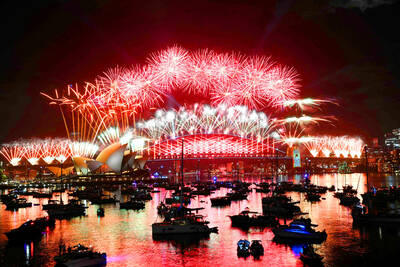Australia yesterday unveiled its first National Defence Strategy, signaling a new focus on deterring China’s “coercive tactics” in the Indo-Pacific region.
The 80-page document offers a gloomy assessment of Pacific security and sets out a massive increase in defense spending to retool Australia’s military to cope with the challenge.
“The optimistic assumptions that guided defense planning after the end of the Cold War are long gone,” Australian Minister for Defence Richard Marles said as he presented the new strategy.
Warning that “China has employed coercive tactics in pursuit of its strategic objectives,” the text describes an Australia vulnerable to foes strangling trade or preventing access to vital air and sea routes.
“We are a maritime trading island nation,” Marles said. “The invasion of Australia is an unlikely prospect in any scenario, precisely because so much damage can be done to our country by an adversary without ever having to step foot on Australian soil.”
Instead of focusing on maintaining a military that can do a range of tasks almost anywhere in the world, Marles said the focus would be on building a force that can protect Australia’s interests in its immediate region.
At the center of the strategy are plans to develop a fleet of stealth nuclear-powered submarines to triple key missile capabilities and develop a large surface combatant fleet.
“Having the most capable navy in our history will be at the heart of our projection and our strategy of denial,” Marles said.
As a share of GDP, defense spending is set to increase from about 2 percent now to 2.4 percent within a decade.
Australia predicted increased risk of conflict in the Taiwan Strait, the South and East China seas, or on the Indian border.
Marles said that old assumptions about how much time Australia would have to prepare for war were gone.
“Australia no longer has the luxury of a 10-year window of strategic warning time for conflict,” he said.
Asked about Canberra’s strategy at a regular briefing, Beijing urged Australia to “refrain from making accusations against China at every turn.”
“China poses no threat to any country,” Chinese Ministry of Foreign Affairs spokesman Lin Jian (林劍) said. “We hope that the Australian side can view China’s development and strategic intentions in a correct light, abandon the Cold War mentality [and] do more to safeguard regional peace and stability.”

Taiwan is gearing up to celebrate the New Year at events across the country, headlined by the annual countdown and Taipei 101 fireworks display at midnight. Many of the events are to be livesteamed online. See below for lineups and links: Taipei Taipei’s New Year’s Party 2026 is to begin at 7pm and run until 1am, with the theme “Sailing to the Future.” South Korean girl group KARA is headlining the concert at Taipei City Hall Plaza, with additional performances by Amber An (安心亞), Nick Chou (周湯豪), hip-hop trio Nine One One (玖壹壹), Bii (畢書盡), girl group Genblue (幻藍小熊) and more. The festivities are to

Auckland rang in 2026 with a downtown fireworks display launched from New Zealand’s tallest structure, Sky Tower, making it the first major city to greet the new year at a celebration dampened by rain, while crowds in Taipei braved the elements to watch Taipei 101’s display. South Pacific countries are the first to bid farewell to 2025. Clocks struck midnight in Auckland, with a population of 1.7 million, 18 hours before the famous ball was to drop in New York’s Times Square. The five-minute display involved 3,500 fireworks launched from the 240m Sky Tower. Smaller community events were canceled across New Zealand’s

‘IRRESPONSIBLE’: Beijing’s constant disruption of the ‘status quo’ in the Taiwan Strait has damaged peace, stability and security in the Indo-Pacific region, MOFA said The Presidential Office yesterday condemned China’s launch of another military drill around Taiwan, saying such actions are a “unilateral provocation” that destabilizes regional peace and stability. China should immediately stop the irresponsible and provocative actions, Presidential Office spokeswoman Karen Kuo (郭雅慧) said, after the Chinese People’s Liberation Army (PLA) yesterday announced the start of a new round of joint exercises around Taiwan by the army, navy and air force, which it said were approaching “from different directions.” Code-named “Justice Mission 2025,” the exercises would be conducted in the Taiwan Strait and in areas north, southwest, southeast and east of Taiwan

UNDER WAY: The contract for advanced sensor systems would be fulfilled in Florida, and is expected to be completed by June 2031, the Pentagon said Lockheed Martin has been given a contract involving foreign military sales to Taiwan to meet what Washington calls “an urgent operational need” of Taiwan’s air force, the Pentagon said on Wednesday. The contract has a ceiling value of US$328.5 million, with US$157.3 million in foreign military sales funds obligated at the time of award, the Pentagon said in a statement. “This contract provides for the procurement and delivery of 55 Infrared Search and Track Legion Enhanced Sensor Pods, processors, pod containers and processor containers required to meet the urgent operational need of the Taiwan air force,” it said. The contract’s work would be